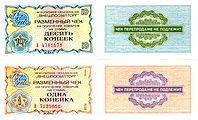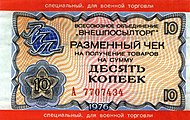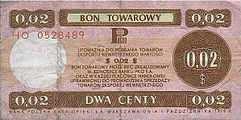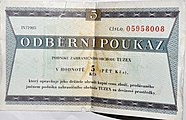Finance:Foreign exchange certificate
From HandWiki
A foreign exchange certificate, sometimes abbreviated to FEC, is a tool for foreign exchange control in countries where the national currency is subject to exchange controls or is not convertible.[1] The arrangements vary significantly case by case.
Common types
Some of the main types of FEC are:
- A certificate for purchasing foreign currency at a specified rate, often for a specified purpose, such as financing imports. This type of certificates were required in many European countries after World War II.
- A certificate denominated in local currency, which foreign citizens are required to use for some or all of their purchases. The exchange rate may be more favourable for the visitor than the official commercial rate. The purpose is to channel the foreign exchange to the state coffers instead of the black market. This type of FECs was in use in Germany in 1931–1948 and China in 1980–1994.
- A certificate to which local citizens are required to exchange any foreign currency they receive as part of their salary or as remittances from relatives or friends who live abroad. These certificates may be accepted as payment in specific stores, which otherwise sell goods only to foreign citizens in exchange for foreign currency. This type of FECs was issued in the Soviet Union between 1961 and 1989.
- Certificates for circulation in closed economic zones (for example, the Svalbard ruble for employees of the Arktikugol coal mines). The purpose of such certificates was to prevent a shortage of goods in the event of an uncontrolled influx of money from outside the zone.
Examples
- FECs denominated in national currency but with a special exchange rate / rules of circulation
- Soviet Union (Torgsin cheques in the 1930s, and various FEC types in 1961–1991, of which Vneshposyltorg cheques were the most common ones)[2]
- China (1980–1994)[3]
- East Germany (forum cheques, pegged to the West German D-Mark)
- North Korea (separate certificates and tokens for "socialist visitors" and "capitalist visitors" were in use between the 1970s and 2008)[4]
- Cuba (from 1985, several different FECs (INTUR cheques) were issued, which were superseded when the US dollar was allowed to circulate, together with the convertible peso)
- Czechoslovakia (Tuzex)
- Bulgaria (Balkan Tourist, Corecom and People's Bank of Bulgaria cheques)[5]
- Communist Romania (NAVROM cheques)[6]
- Vietnam
- Communist Albania – it was illegal to exchange them for regular Albanian lek banknotes.
- Yugoslavia (Putnik cheques in the 1950s, People's Bank of Yugoslavia cheques in the 1980s)
- FECs denominated in a foreign currency (usually the US dollar)
- Myanmar (Burma) (until March 2013)[7]
- Poland [8] (Bon Towarowy PeKaO)
- Zimbabwe (Zimbabwean bond notes and Zimbabwean bond coins)[9]
- Special rules of currency circulation (other than FEC)
- Ghana – it was illegal to import and export Ghanaian cedi banknotes (around 1980)
- Weimar Republic and Nazi Germany[10] (1931–1948)
Gallery
References
- ↑ "Currency Certificate". investopedia. http://www.investopedia.com/terms/c/currency_certificate.asp. Retrieved 19 April 2014.
- ↑ "RUSSIA Paper Money, Foreign Exchange Certificates, 1961–91". http://www.numismondo.net/pm/rus/indexFX10.htm.
- ↑ "Provisional regulations of the Bank of China foreign exchange certificate". http://www.asianlii.org/cn/legis/cen/laws/protbocofec624/. Retrieved 19 April 2014.
- ↑ "North Korea new variety foreign exchange certificate reported". http://www.banknotenews.com/files/93a649a61aef16460ce361b0300d1bbc-1048.php.
- ↑ "Bulgaria paper money catalog and Bulgarian currency history". atsnotes. http://www.atsnotes.com/catalog/banknotes/bulgaria.html. Retrieved 19 April 2014.
- ↑ https://banknote.ws/COLLECTION/countries/EUR/ROM/ROM-FEX.htm
- ↑ "Burma to abolish foreign exchange certificate in 2013". Mizizma. 9 August 2012. http://www.mizzima.com/business/7722-burma-to-abolish-foreign-exchange-certificate-in-2013.html.
- ↑ "POLSKA RZECZPOSPOLITA LUDOWA – POLAND Foreign Exchange Certificates, 1969 Issues". numismondo. http://www.numismondo.net/pm/pol/indexFX21.htm. Retrieved 19 April 2014.
- ↑ https://banknote.ws/COLLECTION/countries/AFR/ZIM/ZIMFXW2009-0050.htm
- ↑ Tooze, Adam (2007). The Wages of Destruction. London: Penguin.
External links
- Chinese foreign exchange certificates (FEC) (in English and German)
- East German forum checks (in English and German)
 |











